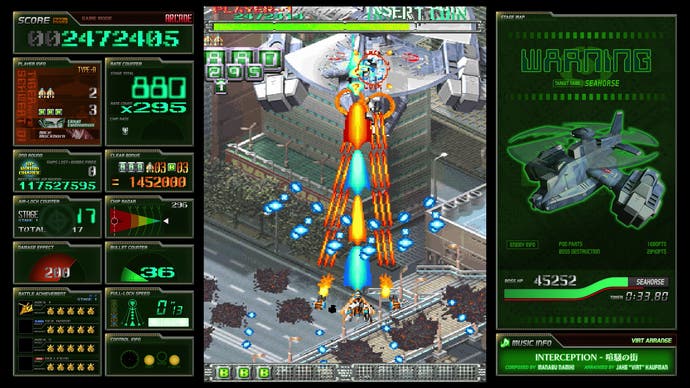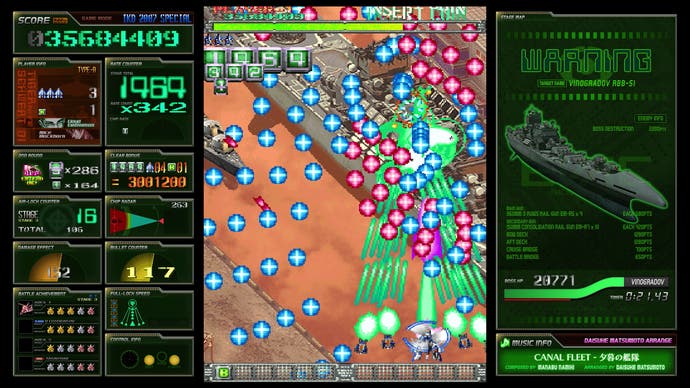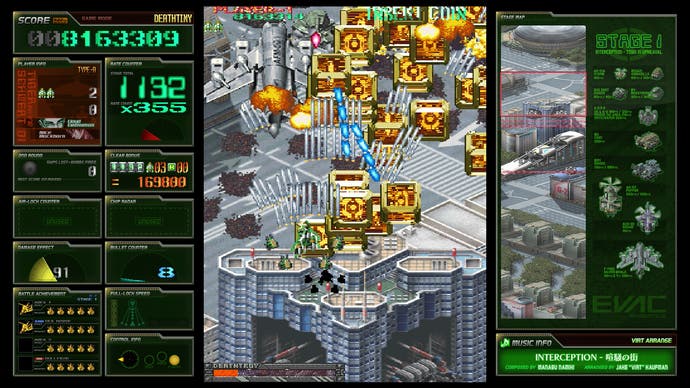Ketsui Deathtiny review: arcade, perfected
A storm in the port.
Spend a decent amount of time in arcades, and you'll inevitably hear musings about 'playing close to the code'.
It's an abstract notion that might not stand up to detailed analysis, but it captures what makes true arcade game forms so compelling. To play close to the code is to experience intimacy with a game's systems, without cut-scenes, narratives and camera angles muddying the waters. It is to interact almost directly with the mathematics and structures that are a scoring-focused arcade game's very foundation.
And bullet hell shmups offer an opportunity to get closer to the code than most. Because while their focus is on dodging swarms of bullets and downing enemies with a billowing stream of gaudy ordinance, to play one is to interact with meticulous, elaborate scoring systems where combo metres, multipliers, rank counters and item values interplay like elements of a numerical Rube Goldberg machine. Boss fights might be a focal point, but the real battle is with the invisible systems behind the pixels. So whether you want to score, survive, or simply play a game as its designers intended, you'll have to get 'close to the code'.
That's easier said than done, of course. Shump gameplay systems can be so arcane they are off-putting for all but the most devoted. Japanese outfit M2 has set out to change that, releasing versions of iconic 2D shooters that do an admirable job of exposing the game behind the gameplay. Battle Garegga, Dangun Feveron, and Mahou Daisakusen have enjoyed much popularity as ports delivered under the M2 Shot Triggers banner. And now, after much anticipation, Cave's beloved shooter Ketsui has joined that stable.

Ketsui Deathtiny is essentially a compilation of Ketsui versions new and old - often called 'arrangements' in arcade parlance - each festooned with M2's 'Gadgets'. The Gadgets are what let players peak into the guts of Cave's brutally demanding shmup, and I'll come back to them after taking a look at the game itself. Front of house in the Deathtiny compendium is a stunningly accurate port of the original 2003 arcade version of Ketsui: full title Ketsui: Kizuna Jigoku Tachi. It's a game that still looks and sounds wonderful 15 years on, and it's thrilling to be able to play such a precise version at home. Ketsui very much continues the tradition of the DoDonPachi games. Thematically it is a hard military shmup, where helicopters, tanks and planes are the focus, instead of the cosplay-baiting characters seen in many contemporary shooters. And if it is hard in theme, it is much harder still in difficulty level.
The arcade mode - and the included IDK 2007 Special version - are relentlessly punishing. In pace, tone, interaction and soundscape Ketsui is a furiously aggressive game. Mesmeric spiralling rigid formations of bullets as seen elsewhere in Cave's discography are relatively rare in Ketsui; instead you'll be pounded with chaotic swarms where bullets travel in myriad different directions. By the second of the five main stages, things get overwhelmingly dense, with erratically shape-shifting gaps providing fleeting, narrow escape routes. In a genre defined by difficulty, Ketsui is one of the toughest there is. It offers a lesson in discipline, but equally it's a chance to wrestle with your own handling of repeated failure.
But whatever your skill level or genre experience, Ketsui is tremendously fun. There aren't many games that throw so much at the player at once, and getting lost in the chaos of a round of Arcade mode is as delightful as it is devastating.

And the scoring? It's sublime and subtle in equal measure, and engenders a risky, flowing play style that sees players riding a wave of scoring opportunity that surges through the game. Topple off that wave, and a comeback can feel insurmountable. Stay with it - even fleetingly - and it makes you feel like a better player than you might ever be.
As with so many shmups that feel dramatic to play because they are founded on a risk/reward dynamic, the scoring in Arcade mode is anchored around proximity kills. Every enemy you down rewards you with scoring 'chips', which carry a value between one and five, and can be scooped up by the player ship. The closer you are at the point of a kill, the higher the chip value. And every time you bag a chip worth two or more, a timer fills, and rapidly depletes. As with so many shumps, you are armed with two weapons, and a bomb. One weapon offers a weaker spread shot, and the other a compact laser. Use of the laser sees ship speed reduce, and the spread shot reinvented as a lock-on weapon.
In the window of time after picking up a higher-value chip, using the lock-on weapons will produce clusters of extra chips at the value of that which you last collected, regardless of proximity to the targeted enemy. Chip value adds to a total tally, which is cashed in as a significant score multiplyer at the end of a stage. Offsetting all of that is the fact that using the lock-on depletes total chip tally, as does time spent conquering a boss.

What is important is how that system impacts the gameplay experience. Ideally, you want to destroy small 'popcorn' enemies at very close proximity, spawning five-value chips, which can then be produced in greater numbers by quickly lock-on killing larger enemies at a distance. Maximising scoring potential, then, requires using popcorn at just the right time, meaning finding a movement pattern through the stages that keeps chip-values high and kills perfectly timed. That is the wave you ride - a form of enemy chaining that while fundamentally comparable to the more conventional systems seen in DoDonPachi and its ilk, is one that demands a rather distinct play-style and scoring strategy.
And it is the M2 Gadgets that let you keep on top of all that. Sitting in the spare screen estate left empty thanks to Ketsui's vertical orientation, the Gadgets communicate a wealth of information beyond the standard that is score and stocks of lives and bombs. They give the player information about chip value, weapon behaviour and ship levels. They're tremendously useful, make understanding Ketsui's systems much easier, and are available across the included arrangements. And it is those other arrangements that make sure Ketsui is accessible to as broad an audience as possible.
The titular Deathtiny mode simplifies the scoring and increases the ability to make screens full of bullets vanish, offering a less demanding way to taste the full Ketsui experience. IDK 2007 Special, meanwhile, provides a more subtle remix of the Arcade version, upping the bullet count in many places, should there be anyone on Earth who doesn't find enough challenge in the original. There are also a pair of arrangements that let you tackle sections of various stages in isolation, rewarding no death/no bomb clears with gold medals. Easily customisable to different skill levels, they serve in part as a sparring tool to improve skills and drill sections of the main game that are besting you.

The standout arrangement outside Arcade mode, however, might just be Super Easy . Often low difficulty versions of demanding shmups remove so many bullets and enemies that there can be too little resource available to engage with the scoring systems, and so few bullets that staying alive becomes rather mindless. Here, however, it is what is left in that makes for such a brilliant mode. Super Easy certainly lives up to its name, and it really doesn't take much to one-credit-clear. But there's just enough left in to mean you can still explore the scoring system, and you'll need to use movement techniques that will come in useful when tackling harder arrangements. In short, Super Easy makes Ketsui extremely accessible, while still providing a chance to play for score and learn high-level techniques.
It really is hard to find much to complain about with Ketsui Deathtiny. The online leaderboards are robust and reliable, an array of options and a Custom mode leave ample opportunity to tweak the game to your desires, and the diversity of arrangements deserves much praise. The menus do involve a lot of Japanese text, and while it's easy enough to blunder your way through it's just as easy to get lost in them, but that's a minor complaint given how exquisite the rest of the package is.
Ketsui Deathtiny is an exceptionally good port of a masterwork of its form. Ketsui already stood out in a genre that enjoys an embarrassment of riches when it comes to nuanced, pure game design. With Deathtiny we have an arcade-perfect port, a suite of different modes, and accessible offerings that stay faithful to what makes a bullet hell shmup so rewarding. Then there's those M2 Gadgets that bring everyone who plays a little bit closer to the code. Indeed, Ketsui Deathtiny trumps the arcade original that is so celebrated.
If you are devoted to shmups, this release is as essential as that Saturn copy of Radiant Silvergun you paid too much for, or even the Ibara Black Label PCB you covet. If your interest in the genre is rather less fervent, Ketsui Deathtiny is probably the one shmup release that should be in any well-rounded game collection.


